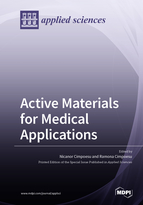Active Materials for Medical Applications
A special issue of Applied Sciences (ISSN 2076-3417). This special issue belongs to the section "Materials Science and Engineering".
Deadline for manuscript submissions: closed (15 August 2021) | Viewed by 25673
Special Issue Editors
Interests: SEM; EDS; EBSD; AFM; biomaterials; biodegradable; ceramic layers; 3D printing
Special Issues, Collections and Topics in MDPI journals
Interests: corrosion resistance; electro-corrosion; EIS; polymers
Special Issues, Collections and Topics in MDPI journals
Special Issue Information
Dear Colleagues,
For the attention of engineers, physicists, medical doctors, researchers, and scientists, we intend to analyze and discuss different topics on active materials for medical applications. There is a great potential in the use of active or smart materials (metallic, polymer or ceramic) for the progress of applications in the medical domain of MEMS, actuators, sensors or functional systems. Active or “smart” materials have the ability to respond to different physical or chemical stimuli in a specific, repeatable mode. The actual activity in the domain, however, presents problems connected to obtaining and processing, characterization, modeling, and simulation or prototyping technologies.
This Special Issue of Applied Sciences intends to focus on the most recent advances in obtaining active materials used in the medical field with enhanced performance.
Prof. Nicanor CimpoesuDr. Ramona Cimpoesu
Guest Editor
Manuscript Submission Information
Manuscripts should be submitted online at www.mdpi.com by registering and logging in to this website. Once you are registered, click here to go to the submission form. Manuscripts can be submitted until the deadline. All submissions that pass pre-check are peer-reviewed. Accepted papers will be published continuously in the journal (as soon as accepted) and will be listed together on the special issue website. Research articles, review articles as well as short communications are invited. For planned papers, a title and short abstract (about 100 words) can be sent to the Editorial Office for announcement on this website.
Submitted manuscripts should not have been published previously, nor be under consideration for publication elsewhere (except conference proceedings papers). All manuscripts are thoroughly refereed through a single-blind peer-review process. A guide for authors and other relevant information for submission of manuscripts is available on the Instructions for Authors page. Applied Sciences is an international peer-reviewed open access semimonthly journal published by MDPI.
Please visit the Instructions for Authors page before submitting a manuscript. The Article Processing Charge (APC) for publication in this open access journal is 2400 CHF (Swiss Francs). Submitted papers should be well formatted and use good English. Authors may use MDPI's English editing service prior to publication or during author revisions.
Keywords
- biodegradable alloy
- shape memory alloy
- biomedical materials
- ceramic materials
- biodegradable polymers
- shape memory polymers
- recovery systems







